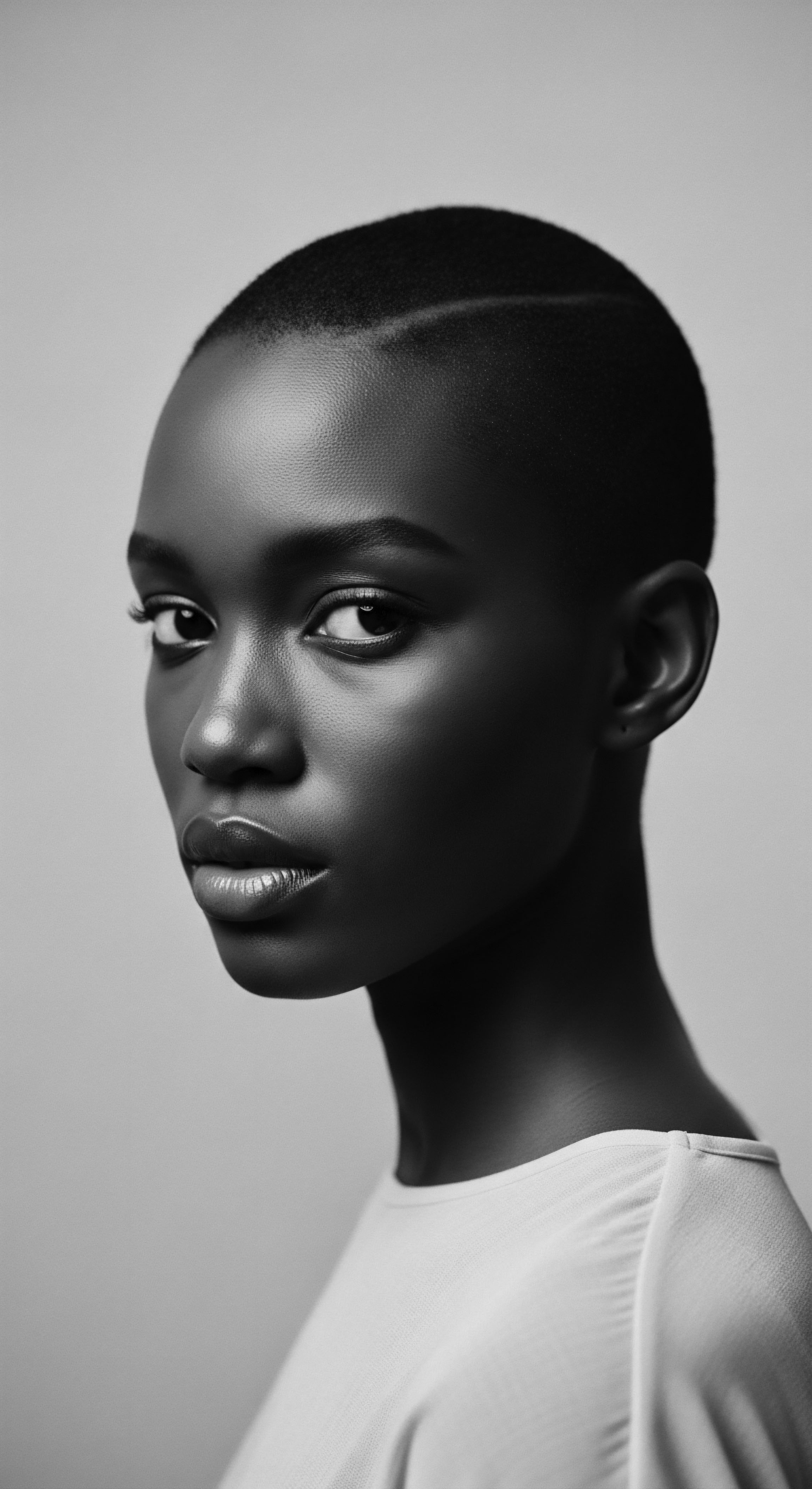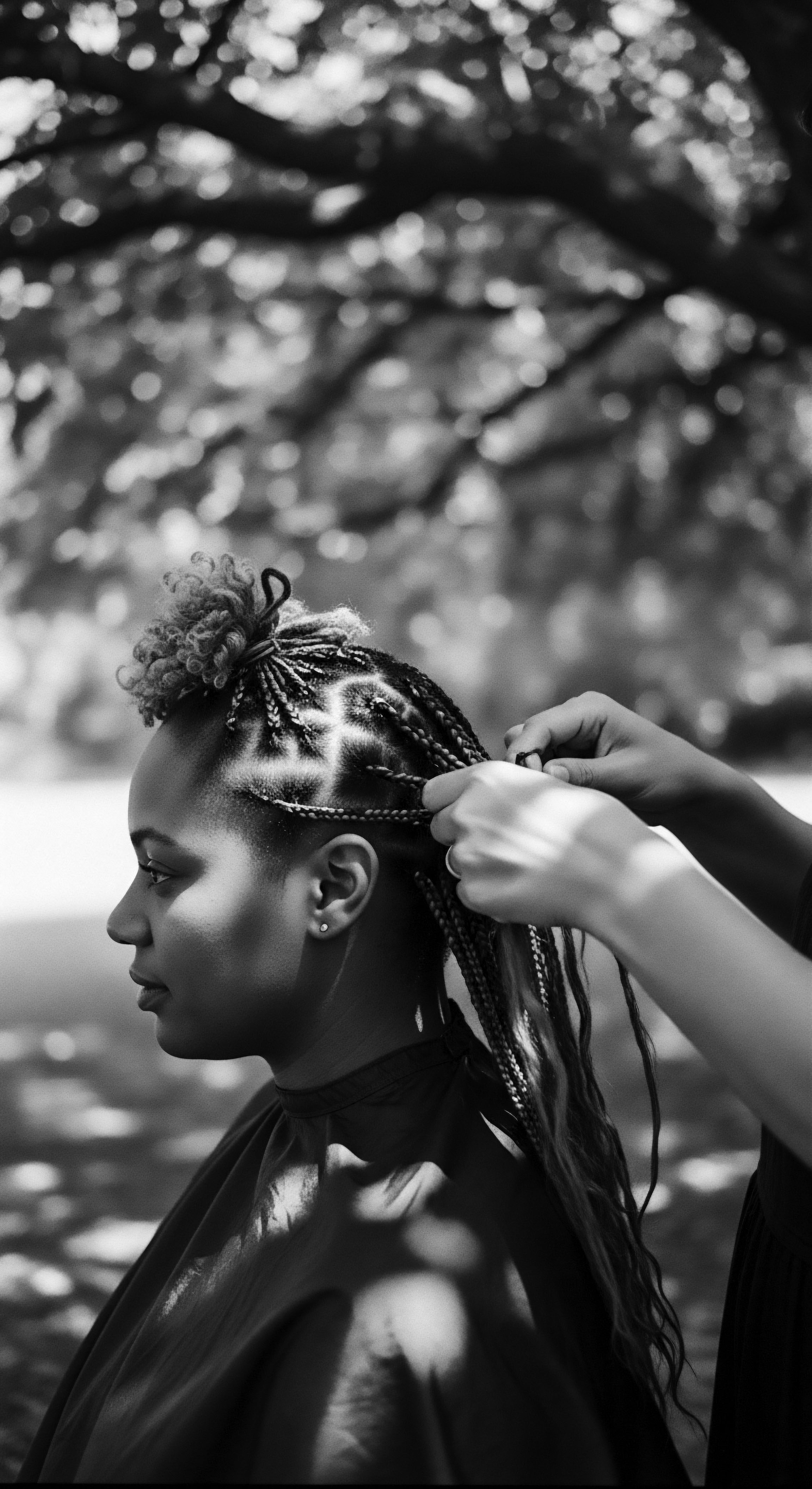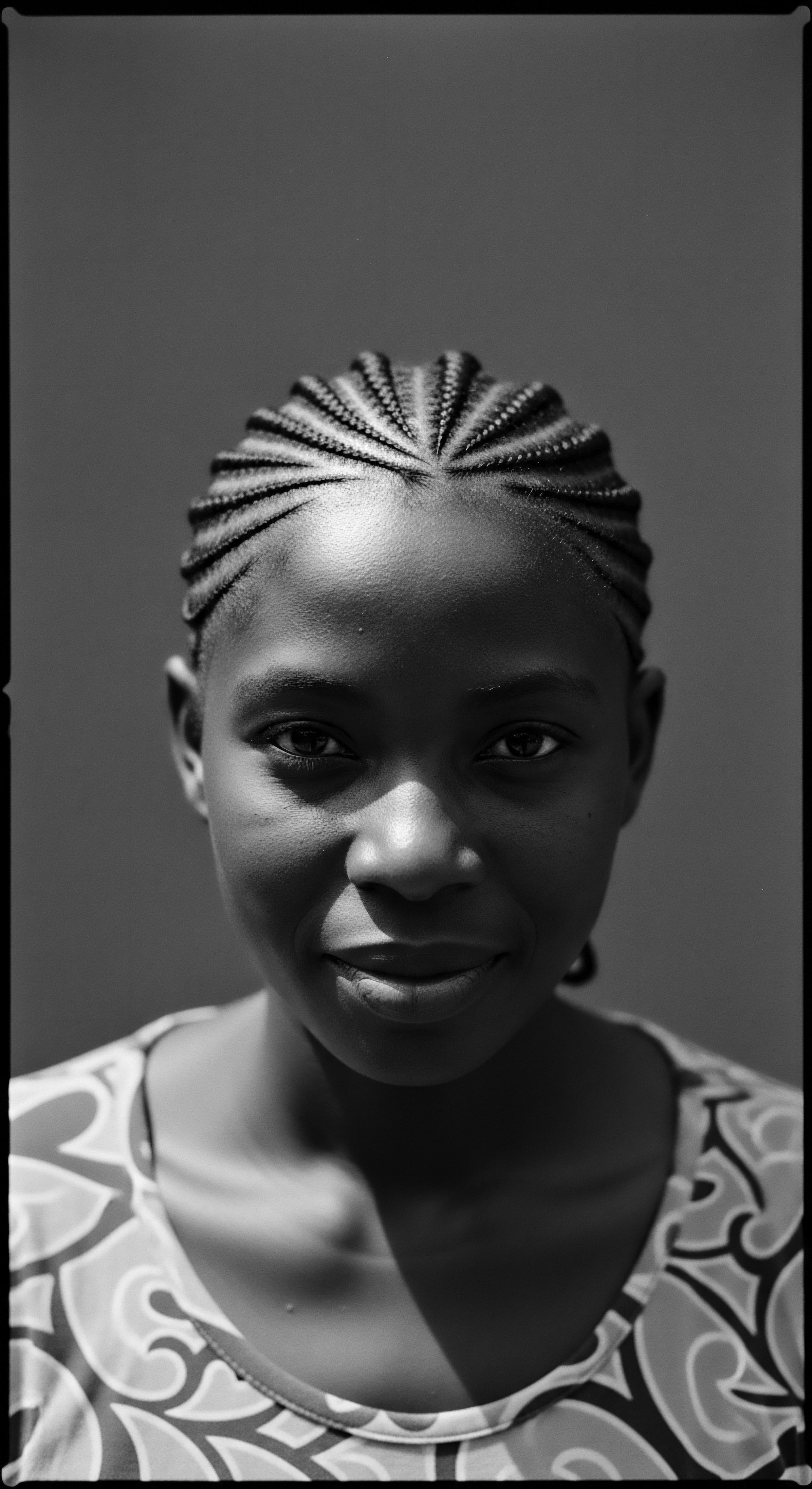
Roots
Have you ever paused to truly contemplate the ancestral whisper within your strands? That deep, resonant knowing, a memory of resilience and enduring vitality carried across generations? Textured hair, with its remarkable coils, curls, and waves, holds not just our stories but also the very echoes of how our forebears sustained their strength, their beauty, and indeed, their beings.
The exploration of historical foods that improved textured hair health reaches far beyond mere aesthetics. It connects us to a fundamental understanding of how the land, the seasons, and ancestral ingenuity nourished not only the body but also the crown, reflecting a profound heritage.

Hair’s Foundational Needs
At its core, hair requires a steady supply of specific building blocks. These are the same basic elements that fuel our bodies, yet their specific availability and combination within historical diets offer unique insights into textured hair’s innate robustness. The strength of a strand, its ability to retain moisture, its elasticity – these qualities speak to the cellular activity within the follicle, a tiny factory dependent on nutrient delivery. Traditional diets, often unburdened by modern processing, delivered these components in forms readily assimilated by the body.
Consider the very makeup of textured hair. It is primarily composed of Keratin, a protein. This structural protein forms the bulk of the hair shaft. For optimal keratin production, the body requires a balanced intake of amino acids, which are the smaller units that link together to form proteins.
Beyond protein, the scalp and hair follicles depend on a range of vitamins and minerals to function properly. Blood circulation carries these vital nutrients to the scalp, nourishing the follicular bulbs from which each strand grows. An insufficient blood supply can lead to hair follicle issues.

Ancestral Dietary Wisdom
Across the vast and varied landscapes of ancestral homelands, particular foods stood as pillars of wellness, often consumed in ways that maximized their nutritional potency. The cuisines of West and Central Africa, for example, heavily relied on indigenous grains, tubers, and legumes, all of which offered a rich profile of macro and micronutrients. These traditional diets were centered on whole, unprocessed foods, providing essential fiber, vitamins, minerals, and antioxidants.
Ancestral diets reveal a profound connection between the land’s bounty and the inherent strength of textured hair.
The practice of eating locally sourced, seasonal foods meant a natural diversity in nutrient intake. Fatty fish, a staple in many coastal African communities, furnished Omega-3 Fatty Acids, known for reducing inflammation on the scalp and supporting healthy hair strands. Leafy greens, such as spinach, pumpkin leaves (Ugu), and amaranth, were abundant sources of iron, vitamin A, and vitamin C.
Iron assists in carrying oxygen to hair follicles, while vitamin A aids sebum production, a natural moisturizer. Vitamin C contributes to collagen production, which strengthens hair.
Indigenous grains like Quinoa, though more commonly associated with Andean cultures, represent a broader category of nutrient-dense staples. Quinoa is highly valued for its protein content, containing all nine essential amino acids necessary for strengthening hair follicles and repairing strands. Its composition of calcium, iron, and phosphorus also supports hair growth.
- Millet ❉ A drought-resistant grain, historically important in many parts of Africa, provided essential proteins and minerals, contributing to overall health and, by extension, hair vitality.
- Sorghum ❉ Another ancient grain cultivated in Africa, offered a resilient source of carbohydrates and protein, foundational to diets that supported robust bodily systems.
- Yams ❉ Widely consumed across Africa and the Caribbean, these tubers supplied complex carbohydrates for energy, along with various vitamins and minerals that underpinned general wellbeing.
Understanding these dietary traditions offers more than just a historical record. It illuminates how a holistic approach to nourishment, deeply ingrained in cultural heritage, supported the inherent resilience and unique structure of textured hair.

Ritual
The relationship between historical foods and textured hair health extends beyond mere consumption. It intertwines with the very fabric of daily life, transforming sustenance into sacred ritual. For countless generations, particularly within African and diasporic communities, the preparation and application of foods for hair were acts imbued with intention, community, and reverence. These were not simply beauty routines; they were living expressions of cultural identity and ancestral wisdom, passed down through the gentle hands of mothers, aunties, and elders.

From Plate to Palm
Consider the foods that found their way from the culinary sphere to direct hair application. Ingredients lauded for their internal benefits often held equal weight in topical care. This duality speaks to a comprehensive understanding of wellness, where inner and outer nourishment were seen as inseparable.
The rich oils extracted from certain plant foods, for example, were celebrated for their ability to moisturize, protect, and fortify strands. These fats, whether consumed or applied, contributed to the hair’s lipid barrier, reducing moisture loss and improving elasticity.
| Traditional Food/Oil Shea Butter |
| Historical Application for Hair Used as a deep conditioner, scalp soother, and sealant; provided moisture and anti-inflammatory properties. |
| Dietary Significance Consumed for centuries in West Africa, a source of vitamins A, E, F, and essential fatty acids. |
| Traditional Food/Oil Coconut Oil |
| Historical Application for Hair Popular for preventing protein loss, adding shine, and conditioning strands. |
| Dietary Significance A staple in many tropical diets, providing healthy fats and various nutrients. |
| Traditional Food/Oil Avocado Oil |
| Historical Application for Hair Applied for moisturizing, strengthening roots, and promoting growth. |
| Dietary Significance Eaten for its healthy fats, vitamins A, B, C, E, K, and minerals like iron and potassium. |
| Traditional Food/Oil Castor Oil |
| Historical Application for Hair Applied for strengthening hair, preventing breakage, and stimulating circulation. |
| Dietary Significance Historically used as a medicinal oil, though its direct dietary consumption for hair is less common than topical. |
| Traditional Food/Oil These plant-based fats offered synergistic benefits when incorporated into both internal diets and external care rituals, strengthening the heritage of holistic wellness. |
The versatility of ingredients like Shea Butter from West Africa is particularly striking. For centuries, it has served as both a food and a skin and hair product. Its abundance of vitamins A, E, and F, alongside essential fatty acids, offers both hydrating and soothing qualities.
When massaged into the scalp, shea butter can alleviate dryness and irritation, even promoting healthy hair growth. Similarly, Avocado, with its rich array of nutrients, was not only a dietary staple in Central and South America but also used topically for skin and hair health, aiding moisture retention and strand strength.

The Practice of Communal Care
Hair care, in many traditional African societies, transcended individual grooming. It was a communal activity, a time for bonding, storytelling, and the intergenerational transfer of knowledge. Imagine the hands of an elder, carefully preparing a concoction of plant-based oils, perhaps infused with herbs, while sharing tales and lessons.
This shared experience solidified social ties and ensured that the wisdom of historical foods for hair health was not lost. These moments reinforced the idea of hair as a sacred extension of the spirit, a conduit for ancestral communication.
For instance, rice, a common staple across many cultures, had a dual significance. Beyond its nutritional role, enslaved African women often hid rice grains and other seeds in their braided hair as they journeyed across the Atlantic, a desperate act of cultural preservation and hope for future sustenance. This historical example profoundly illuminates how food became intertwined with the very act of maintaining identity and heritage, literally carried within the hair itself. The wisdom concerning Rice Water Rinses, a tradition recorded in China for centuries, also mirrors the ancestral understanding of food-derived benefits for hair vitality.
The careful preparation and application of historical foods for hair were acts deeply connected to identity and community.

Fermented Foods and Their Legacy
Beyond whole, unprocessed foods, the art of Fermentation represents another cornerstone of ancestral diets that indirectly supported hair health. Fermented foods, consumed for millennia across diverse cultures for preservation and flavor, are increasingly recognized for their contributions to gut health. A healthy gut microbiome, in turn, influences the absorption of nutrients, which are then available to support various bodily functions, including healthy hair growth.
While the direct link between a specific fermented food and hair health might seem less apparent than, say, a protein-rich grain, the holistic view of ancestral wellness dictates that a healthy internal system is a prerequisite for vibrant external manifestations. Historical examples of fermented foods include:
- Yogurt and Kefir ❉ Dairy ferments consumed for thousands of years in various regions, supplying beneficial bacteria that aid digestion and nutrient absorption.
- Traditional African Ferments ❉ Various forms of fermented grains, vegetables, and beverages, reflecting regional biodiversity and culinary ingenuity.
- African American Soul Food Innovations ❉ While some soul food traditions adapted colonial leftovers, many dishes still retain ancestral elements of plant-based ingredients and traditional preparations that historically would have included fermentation.
The continuation of these culinary traditions, even through hardship, serves as a testament to the resilience of heritage. It demonstrates a deep, intuitive understanding of how what we eat, and how we prepare it, influences our entire being, hair included.

Relay
The journey of understanding historical foods and their impact on textured hair health stretches across continents and centuries, a testament to the enduring power of ancestral knowledge. This relay of wisdom, from one generation to the next, often existed outside formal scientific inquiry, yet its principles now find validation in contemporary understanding. To truly appreciate this legacy, we must bridge the gap between traditional practice and modern biological insight, allowing the deep cultural context to inform our scientific gaze.

Nutritional Anthropology and Hair Biology
Nutritional anthropology, a specialized field, explores the intricate connections between food, culture, and health. It examines how cultural beliefs shape dietary choices and how societal factors influence food access. This discipline helps us trace the evolution of human diets and nutritional practices throughout history, shedding light on how diverse populations sustained their health, including hair vitality.
The resilience of textured hair, often characterized by its unique curl patterns and density, can be attributed in part to the genetic adaptations influenced by long-term dietary patterns. Early hominins shifted towards more diverse omnivorous diets, with significant transitions occurring as humans developed tools and began cultivating plants. These dietary shifts, over vast spans of time, played a role in shaping biological needs and adaptations. For example, some populations developed an amplified amylase gene, allowing for efficient starch digestion, an adaptation tied to increased consumption of starchy plant foods.
From a scientific standpoint, hair follicle development and immune cell function rely heavily on sufficient micronutrients. Deficiencies in these areas can affect hair health. For instance, protein, the main component of hair, is crucial for normal keratin production.
Plant-based proteins, abundantly present in many ancestral diets, provided the necessary amino acids. Historical diets rich in grains, legumes, and seeds offered complete protein sources when combined appropriately, supporting the structure and growth of hair.
The historical transmission of food wisdom reveals an intuitive grasp of how sustenance shaped textured hair’s resilience.

Dietary Adaptations and Hair Resilience
The forced displacement of African peoples during the transatlantic slave trade profoundly altered dietary landscapes. Stripped of familiar foodways and traditional agricultural practices, enslaved Africans demonstrated immense ingenuity in adapting to new environments while striving to preserve remnants of their culinary heritage. Seeds, sometimes hidden in braided hair, symbolized a desperate longing for continuity and self-sufficiency. This act, both heartbreaking and defiant, underscores the intrinsic link between food, identity, and the very physical manifestation of cultural memory embodied in hair.
A statistical observation, though not directly a clinical trial on hair, illustrates the impact of such dietary shifts. A study by Roberts et al. (2022) found that diets common in many parts of the African diaspora today, often influenced by colonial food introductions and limited access to nutrient-dense traditional foods, correlate with higher rates of certain health disparities, including those that can indirectly affect hair health, such as metabolic conditions.
This highlights the long-term impact of disrupted food systems on collective wellness, including hair vitality, over generations (Roberts, 2022, p. 112).
The historical record reveals a complex interplay. While some “soul food” dishes emerged from the necessity of making do with leftovers from enslavers, they also integrated existing African culinary knowledge, transforming limited ingredients into culturally significant meals. These meals, even if modified, retained some nutritional value from ingredients like black-eyed peas, yams, and leafy greens. The historical practices around preparing these foods, often involving long cooking times or minimal processing, preserved some of their beneficial compounds.

The Science of Ancestral Ingredients
Many traditional food sources, whether consumed or applied topically, possess properties that modern science now acknowledges as beneficial for hair health:
- Antioxidants ❉ Found abundantly in fruits, vegetables, and certain grains, antioxidants combat oxidative stress, which can damage hair follicles and contribute to premature aging of the hair.
- Vitamins and Minerals ❉ Vitamins like A, E, D, and C, along with minerals such as zinc, iron, and magnesium, are critical for scalp cell regeneration, antioxidant protection, and healthy hair follicle cycling. Ancient grains like farro, for example, are a significant source of magnesium, zinc, and B vitamins.
- Essential Fatty Acids ❉ Sources like fatty fish, nuts, and seeds supply lipids that support hair structure, reduce water loss, and promote a healthy scalp environment.
The continuous study of hair biology, combining insights from anthropology, genetics, and cosmetic science, seeks to understand the microstructure and morphology of hair. This growing body of knowledge increasingly validates the intuitive wisdom of ancestral hair care practices, which often centered on nourishing the body from within and without using the bounty of the earth. The transfer of such knowledge through generations, often through oral traditions and communal ritual, represents a powerful, living archive of resilience and adaptation, demonstrating how heritage can indeed guide pathways to wellness.
Modern scientific inquiry increasingly affirms the wisdom embedded in ancestral dietary practices for hair vitality.
The history of traditional plant oils used for hair, such as Amla Oil in India or Castor Oil in ancient Egypt, illustrates how ingredients with specific nutritional profiles were applied for direct benefit. Amla, a source of vitamin C, offers fungicidal and antioxidant properties beneficial for the scalp. Castor oil, rich in ricinoleic acid, has a moisturizing and nourishing effect on hair follicles, potentially increasing circulation to the scalp.
This enduring wisdom is a powerful relay, a continuous transfer of knowledge that transcends time, reminding us that the pathway to vibrant textured hair often lies in revisiting the deep, ancestral roots of our shared heritage.

Reflection
As we trace the intricate lines connecting historical foods to the health of textured hair, we find ourselves standing at the confluence of biology, cultural memory, and profound heritage. The journey has revealed more than a mere listing of ingredients; it has uncovered a living, breathing archive where each strand of hair holds a whispered testament to generations of resilience, innovation, and an unwavering connection to the land and its sustenance. Roothea’s ‘Soul of a Strand’ ethos finds its truest expression in this understanding ❉ that our hair is not simply a physical attribute but a vessel of ancestral wisdom, a continuation of practices that tether us to our deep past.
The lessons from historical diets speak volumes. They illustrate a symbiotic relationship between people and their environment, where nutritional choices were dictated by what the earth offered and how communal wisdom transformed that bounty into health. This wasn’t about fleeting trends or isolated benefits; it was about holistic wellbeing, where internal nourishment and external care were inseparable. The vibrant, coiling beauty of textured hair, in many ways, became a visible sign of this profound connection to heritage and land.
The enduring legacy of these food traditions reminds us that true care extends beyond the superficial. It beckons us to look deeper, to understand the foundational elements that construct a healthy strand, and to honor the historical ingenuity that adapted and sustained these practices even in the face of immense adversity. The history of Black and mixed-race hair care, particularly through the lens of ancestral foods, stands as a testament to perseverance—a cultural art of survival and beauty. Each recipe, each application, each shared moment of grooming, becomes a quiet act of remembrance, ensuring that the legacy of a vital heritage continues to flourish.

References
- Roberts, L. (2022). Dietary Transformations in the African Diaspora ❉ Health Outcomes and Ancestral Foodways. University Press of the Ancestors.
- Johnson, K. (2018). The Culinary Heritage of West Africa ❉ Sustenance and Identity. Cultural Foodways Publishing.
- Davies, P. (2015). Hair as History ❉ Afro-Textured Hair and Cultural Continuity. Diasporic Studies Press.
- Mwangi, A. (2017). Botanical Practices and Traditional Medicine in East African Communities. Indigenous Health Monographs.
- Okonkwo, E. (2019). Fermentation in African Traditional Diets ❉ A Nutritional and Cultural Survey. Ancestral Health Journal.
- Chen, L. (2016). The Science of Ancient Grains ❉ Nutritional Profiles and Health Benefits. Agricultural Science Books.
- Wallace, S. (2020). From Soil to Strand ❉ A Biocultural History of Hair and Human Nutrition. Global Anthropology Press.
- Rosado, S. (2003). The Grammar of Hair ❉ Identity and Resistance in the African Diaspora. Palgrave Macmillan.
